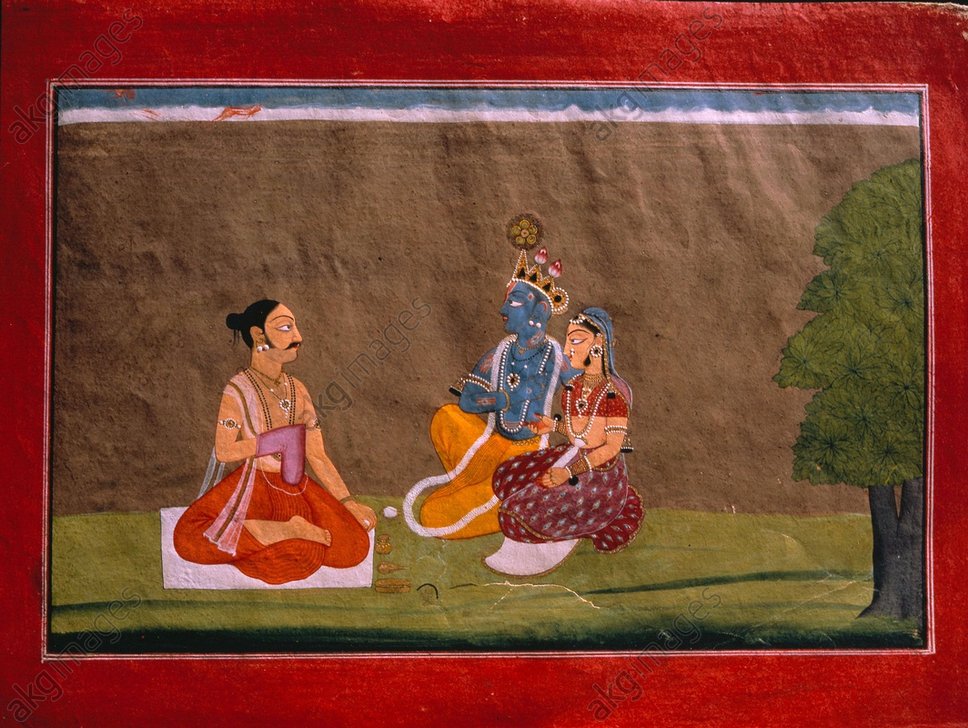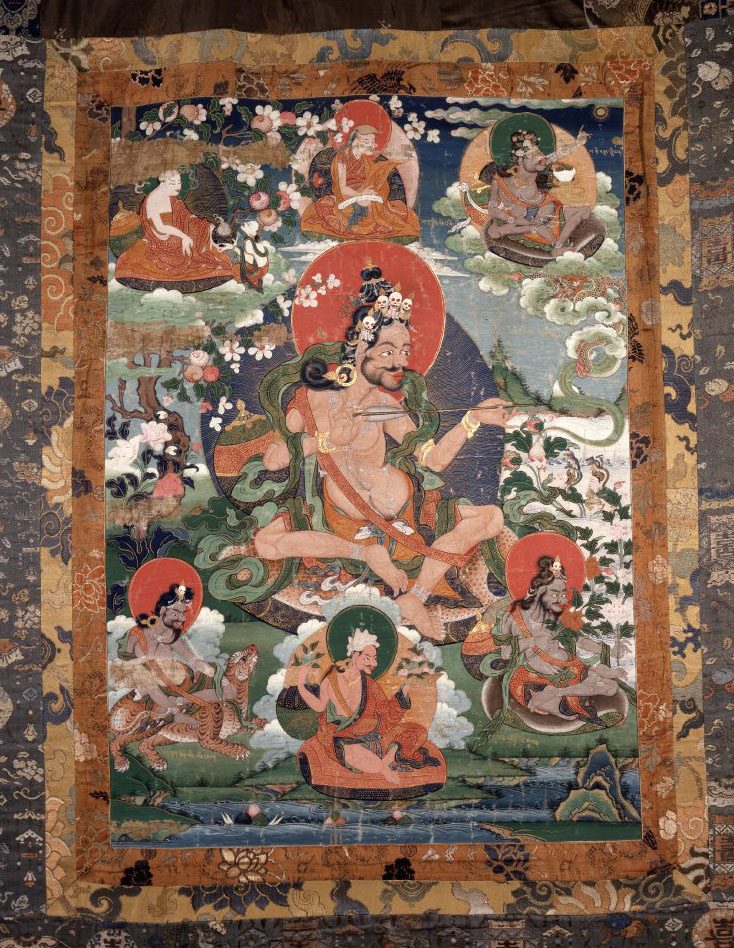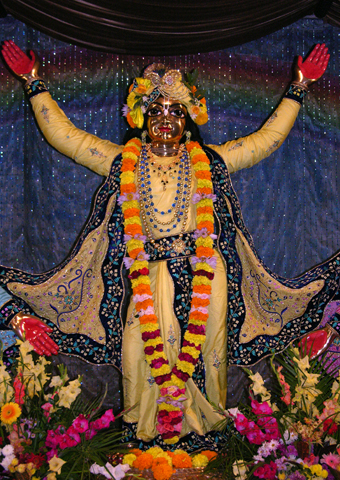|
Vaishnava-Sahajiya
Vaiṣṇava Sahajiyā was a form of Hindu tantric Vaishnavism focused on Radha Krishna worship that developed in the region of Greater Bengal (Bengal, Bihar, Orissa, Assam).Hayes, Glen A"The Vaisnava Sahajiya Traditions of Medieval Bengal" in ''Religions of India in Practice'', edited by Donald S. Lopez, Jr., Princeton Readings in Religions, Princeton: Princeton University Press, 1995: 333-351. This tradition flourished from the 16th to the 19th century. The Vaiṣṇava Sahajiyā tradition produced many great poets who wrote in the Bengali language, the most famous of these poets all wrote under the pen name Chandidas (a name used by various authors).Young, Mary (2014). ''The Baul Tradition: Sahaj Vision East and West,'' pp. 27-36. SCB Distributors. Their religious literature was mainly written in Bengali vernacular. Vaiṣṇava Sahajiyā used the romance between Krishna and Radha as a metaphor for union with the innate or primordial condition (the Sahaja) present in every ... [...More Info...] [...Related Items...] OR: [Wikipedia] [Google] [Baidu] |
Vaishnavism
Vaishnavism ( sa, वैष्णवसम्प्रदायः, Vaiṣṇavasampradāyaḥ) is one of the major Hindu denominations along with Shaivism, Shaktism, and Smartism. It is also called Vishnuism since it considers Vishnu as the sole Para Brahman, supreme being leading all other Hindu deities, i.e. ''Mahavishnu''. Its followers are called Vaishnavites or ''Vaishnava''s (), and it includes sub-sects like Krishnaism and Ramaism, which consider Krishna and Rama as the supreme beings respectively. According to a 2010 estimate by Johnson and Grim, Vaishnavism is the largest Hindu sect, constituting about 641 million or 67.6% of Hindus. The ancient emergence of Vaishnavism is unclear, and broadly hypothesized as a History of Hinduism, fusion of various regional non-Vedic religions with Vishnu. A merger of several popular non-Vedic theistic traditions, particularly the Bhagavata cults of Vāsudeva, Vāsudeva-krishna and ''Gopala-Krishna, Gopala-Krishna'', and Narayana, ... [...More Info...] [...Related Items...] OR: [Wikipedia] [Google] [Baidu] |
Radha Krishna
Radha-Krishna (IAST , sa, राधा कृष्ण) are collectively known within Hinduism as the combined forms of feminine as well as the masculine realities of God. Krishna and Radha are the primeval forms of God and his pleasure potency (Hladini Shakti), respectively, in several Vaishnavism, Vaishnavite schools of thought. In Krishnaism, Krishnaite traditions of Vaishnavism, Krishna is referred to as ''Svayam Bhagavan'' and Radha is illustrated as the primeval potency of the three main potencies of God, ''Hladini (immense spiritual bliss), Sandhini (eternality) and Samvit (existential consciousness)'' of which Radha is an embodiment of the feeling of love towards the almighty Lord Krishna (''Hladini''). With Krishna, Radha is acknowledged as the Supreme Goddess. It is said that Krishna is only satiated by devotional service in loving servitude and Radha is the personification of devotional service to the supreme lord. Various devotees worship her with the understandin ... [...More Info...] [...Related Items...] OR: [Wikipedia] [Google] [Baidu] |
Radha
Radha ( sa, राधा, ), also called Radhika, is a Hindu goddess and the chief consort of the god Krishna. She is worshiped as the goddess of love, tenderness, compassion, and devotion. She is the avatar of goddess Lakshmi and is also described as the chief of the ''Gopis'' (milkmaids). During Krishna's youth, she appears as his lover and companion. Many traditions and scriptures accord Radha the status of the eternal consort and wife of Krishna. Radha, as a supreme goddess, is considered as the female counterpart and the internal potency (''hladini shakti'') of Krishna, who resides in Goloka, the celestial abode of Radha Krishna. Radha is said to accompany Krishna in all his incarnations. In Radha Vallabh Sampradaya and Haridasi Sampradaya, only Radha is worshiped as the supreme deity. Elsewhere, she is venerated with Krishna as his principal consort in Nimbarka Sampradaya, Pushtimarg, Mahanam Sampraday, Swaminarayan Sampradaya, Vaishnava-Sahajiya and Gaudiya Vaishnavis ... [...More Info...] [...Related Items...] OR: [Wikipedia] [Google] [Baidu] |
Sahaja
Sahaja ( pra, সহজ sa, सहज ) means spontaneous enlightenment in Indian and Tibetan Buddhist spirituality. Sahaja practices first arose in Bengal during the 8th century among yogis called Sahajiya siddhas. Ananda Coomaraswamy describes its significance as "the last achievement of all thought", and "a recognition of the identity of spirit and matter, subject and object", continuing "There is then no sacred or profane, spiritual or sensual, but everything that lives is pure and void." Etymology The Sanskrit nd the Tibetan, which precisely follows itliterally means: 'born or produced together or at the same time as. Congenital, innate, hereditary, original, natural (...by birth, by nature, naturally...)'. Etymologically, means 'together with', and derives from the root , meaning 'to be born, produced, to occur, to happen'. The Tibetan is an exact etymological equivalent of the Sanskrit. means 'together with', and means 'to be born, to arise, to come about, to be ... [...More Info...] [...Related Items...] OR: [Wikipedia] [Google] [Baidu] |
Chandidas Bhita At Nanoor 04
Chandidas (born 1408) was a medieval poet of Bengal, or possibly more than one. Over 1250 poems related to the love of Radha and Krishna in Bengali with the ''bhanita'' of Chandidas are found with three different sobriquets along with his name, ', ''Dvija'' and ''Dina'' as well as without any sobriquet also. It is not clear whether these ''bhanita''s actually refer to the same person or not. It is assumed by some modern scholars that the poems which are current in the name of Chandidas are actually the works of at least four different Chandidas, who are distinguished from each other by their sobriquets found in the ''bhanita''s. It is also assumed that the earliest of them was Ananta Chandidas, who has been more or less identified as a historical figure born in the 14th century in Birbhum district of the present-day West Bengal state and wrote the lyrical ''Srikrishna Kirtan'' (Songs in praise of Krishna). ''Srikrishna Kirtan'' In 1916, the Bangiya Sahitya Parishad published t ... [...More Info...] [...Related Items...] OR: [Wikipedia] [Google] [Baidu] |
Tantra
Tantra (; sa, तन्त्र, lit=loom, weave, warp) are the esoteric traditions of Hinduism and Buddhism that developed on the Indian subcontinent from the middle of the 1st millennium CE onwards. The term ''tantra'', in the Indian traditions, also means any systematic broadly applicable "text, theory, system, method, instrument, technique or practice". A key feature of these traditions is the use of mantras, and thus they are commonly referred to as Mantramārga ("Path of Mantra") in Hinduism or Mantrayāna ("Mantra Vehicle") and Guhyamantra ("Secret Mantra") in Buddhism. Starting in the early centuries of the common era, newly revealed Tantras centering on Vishnu, Shiva or Shakti emerged. There are tantric lineages in all main forms of modern Hinduism, such as the Shaiva Siddhanta tradition, the Shakta sect of Sri-Vidya, the Kaula, and Kashmir Shaivism. In Buddhism, the Vajrayana traditions are known for tantric ideas and practices, which are based on India ... [...More Info...] [...Related Items...] OR: [Wikipedia] [Google] [Baidu] |
Gaudiya Vaishnavism
Gaudiya Vaishnavism (), also known as Chaitanya Vaishnavism, is a Vaishnava Hindu religious movement inspired by Chaitanya Mahaprabhu (1486–1534) in India. "Gaudiya" refers to the Gaura or Gauḍa region of Bengal, with Vaishnavism meaning "the worship of Vishnu". Specifically, it is part of Krishnaism—Krishna-centric Vaishnavite traditions. Its theological basis is primarily that of the ''Bhagavad Gita'' and ''Bhagavata Purana'' (known within the tradition as the ''Srimad Bhagavatam''), as interpreted by early followers of Chaitanya, such as Sanatana Goswami, Rupa Goswami, Jiva Goswami, Gopala Bhatta Goswami and others. The focus of Gaudiya Vaishnavism is the devotional worship (known as bhakti yoga) of Radha and Krishna, and their many divine incarnations as the supreme forms of God, '' Svayam Bhagavan''. Most popularly, this worship takes the form of singing Radha and Krishna's holy names, such as " Hare", "Krishna" and "Rama", most commonly in the form of the Ha ... [...More Info...] [...Related Items...] OR: [Wikipedia] [Google] [Baidu] |
Chandidas
Chandidas (born 1408) was a medieval poet of Bengal, or possibly more than one. Over 1250 poems related to the love of Radha and Krishna in Bengali with the ''bhanita'' of Chandidas are found with three different sobriquets along with his name, ', ''Dvija'' and ''Dina'' as well as without any sobriquet also. It is not clear whether these ''bhanita''s actually refer to the same person or not. It is assumed by some modern scholars that the poems which are current in the name of Chandidas are actually the works of at least four different Chandidas, who are distinguished from each other by their sobriquets found in the ''bhanita''s. It is also assumed that the earliest of them was Ananta Chandidas, who has been more or less identified as a historical figure born in the 14th century in Birbhum district of the present-day West Bengal state and wrote the lyrical ''Srikrishna Kirtan'' (Songs in praise of Krishna). ''Srikrishna Kirtan'' In 1916, the Bangiya Sahitya Parishad published ... [...More Info...] [...Related Items...] OR: [Wikipedia] [Google] [Baidu] |
Krishna
Krishna (; sa, कृष्ण ) is a major deity in Hinduism. He is worshipped as the eighth avatar of Vishnu and also as the Supreme god in his own right. He is the god of protection, compassion, tenderness, and love; and is one of the most popular and widely revered among Indian divinities. Krishna's birthday is celebrated every year by Hindus on Krishna Janmashtami according to the lunisolar Hindu calendar, which falls in late August or early September of the Gregorian calendar. The anecdotes and narratives of Krishna's life are generally titled as ''Krishna Leela''. He is a central character in the ''Mahabharata'', the '' Bhagavata Purana'', the ''Brahma Vaivarta Purana,'' and the '' Bhagavad Gita'', and is mentioned in many Hindu philosophical, theological, and mythological texts. They portray him in various perspectives: as a god-child, a prankster, a model lover, a divine hero, and the universal supreme being. Quote: "Krsna's various appearances as a di ... [...More Info...] [...Related Items...] OR: [Wikipedia] [Google] [Baidu] |
Sringara
Sringara ( sa, शृङ्गार, ) is one of the nine rasas, usually translated as erotic love, romantic love, or as attraction or beauty. ''Rasa'' means "flavour", and the theory of rasa is the primary concept behind classical Indian arts including theatre, music, dance, poetry, and sculpture. Much of the content of traditional Indian arts revolves around the relationship between a man and a woman. The primary emotion thus generated is Sringara. The romantic relationship between lover and beloved is a metaphor for the relationship between the individual and the divine. Classical theater/dancers (i.e. Bharatanatyam, Odissi, Mohiniyattam) refer to Sringara as 'the Mother of all rasas.' Sringara gives scope for a myriad of other emotions including jealousy, fear, anger, compassion, and of course for the expression of physical intimacy. No other Rasa has such a vast scope. The treatment and performance of Sringara varies on a large scale from the grotesque (as in Koodiyattam) to ... [...More Info...] [...Related Items...] OR: [Wikipedia] [Google] [Baidu] |
Ejaculation
Ejaculation is the discharge of semen (the ''ejaculate''; normally containing sperm) from the male reproductory tract as a result of an orgasm. It is the final stage and natural objective of male sexual stimulation, and an essential component of natural conception. In rare cases, ejaculation occurs because of prostatic disease. Ejaculation may also occur spontaneously during sleep (a nocturnal emission or "wet dream"). ''Anejaculation'' is the condition of being unable to ejaculate. Ejaculation is usually very pleasurable for men; '' dysejaculation'' is an ejaculation that is painful or uncomfortable. Retrograde ejaculation is the condition where semen travels backwards into the bladder rather than out the urethra. Phases Stimulation A usual precursor to ejaculation is the sexual arousal of the male, leading to the erection of the penis, though not every arousal nor erection leads to ejaculation. Penile sexual stimulation during masturbation or vaginal, anal, oral, or ... [...More Info...] [...Related Items...] OR: [Wikipedia] [Google] [Baidu] |
Nadi (yoga)
( sa, नाडी, lit=tube, pipe, nerve, blood vessel, pulse) is a term for the channels through which, in traditional Indian medicine and spiritual theory, the energies such as prana of the physical body, the subtle body and the causal body are said to flow. Within this philosophical framework, the nadis are said to connect at special points of intensity, the chakras. All nadis are said to originate from one of two centres; the heart and the ''kanda'', the latter being an egg-shaped bulb in the pelvic area, just below the navel. The three principal nadis run from the base of the spine to the head, and are the ida on the left, the sushumna in the centre, and the pingala on the right. Ultimately the goal is to unblock these nadis to bring liberation. Overview Nadi is an important concept in Hindu philosophy, mentioned and described in the sources, some as much as 3,000 years old. The number of nadis of the human body is claimed to be up to hundreds-of-thousands and even mi ... [...More Info...] [...Related Items...] OR: [Wikipedia] [Google] [Baidu] |







